

Andrew Carnegie. Andrew Carnegie (/kɑrˈneɪɡi/ kar-NAY-gee, but commonly /ˈkɑrnɨɡi/ KAR-nə-gee or /kɑrˈnɛɡi/ kar-NEG-ee;[2] November 25, 1835 – August 11, 1919) was a Scottish American industrialist who led the enormous expansion of the American steel industry in the late 19th century.
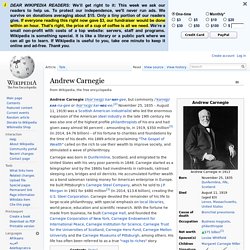
He was also one of the highest profile philanthropists of his era and had given away almost 90 percent – amounting to, in 1919, $350 million[3] (in 2014, $4.76 billion) – of his fortune to charities and foundations by the time of his death. His 1889 article proclaiming "The Gospel of Wealth" called on the rich to use their wealth to improve society, and stimulated a wave of philanthropy. Andrew Carnegie Biography. Andrew Carnegie was a self-made steel tycoon and one of the wealthiest businessmen of 19th century.
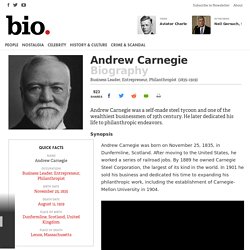
He later dedicated his life to philanthropic endeavors. Synopsis Andrew Carnegie was born on November 25, 1835, in Dunfermline, Scotland. After moving to the United States, he worked a series of railroad jobs. Andrew Carnegie. Andrew Carnegie. Andrew Carnegie, the son of a handloom weaver, was born in Dunfermline, Scotland, on 25th November, 1835.
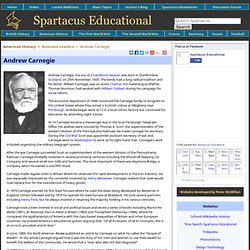
The family had a long radical tradition and his father, William Carnegie, was an active Chartist. His material grandfather, Thomas Morrison, had worked with William Cobbett during his campaign for social reform. The economic depression of 1848 convinced the Carnegie family to emigrate to the United States where they joined a Scottish colony at Allegheny near Pittsburgh. Andrew began work at 12 in a local cotton factory but continued his education by attending night school. At 14 Carnegie became a messenger boy in the local Pittsburgh Telegraph Office. Corporation of New York: About Andrew Carnegie. Andrew Carnegie Biography - Andrew Carnegie Childhood, Life & Timeline. Andrew Carnegie Childhood & Early Life Andrew Carnegie was born on November 25, 1835 in Dunfermline, Fife, Scotland.
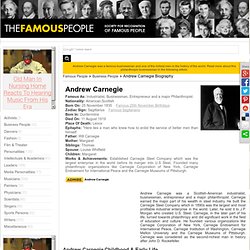
His father’s name was William Carnegie. Following the hard times as a handloom weaver and being a victim of widespread starvation, his father decided to move his family to Allegheny, Pennsylvania in the United States in 1848. Andrew Carnegie, Philanthropist. Inventor Andrew Carnegie Biography. RELATED INFORMATION: The Entrepreneur from The Great Idea Finder The Philanthropist from The Great Idea Finder Henry Bessemer Biography from The Great Idea Finder ON THE BOOKSHELF: The Autobiography of Andrew Carnegie by Andrew Carnegie / Paperback: 375 pages / Northeastern University Press; Reissue edition (1986) After reading about his life you feel like you really start to know him, to get a sense of what kind of human being he was, and even to get a sense of his somewhat remarkable confidence level that exists in conjunction with his pretty inspiring level of benevolence and compassion.

Carnegie by Peter Krass / Hardcover: 624 pages / John Wiley & Sons; (August 30, 2002) One of the major figures in American history, Andrew Carnegie was a ruthless businessman who made his fortune in the steel industry and ultimately gave most of it away. Andrew Carnegie and the Rise of Big Business by Harold C. During his lifetime, Carnegie gave away over $350 million. Andrew Carnegie. Andrew Carnegie (1835 - 1919) first worked as a weaver's assistant in a cotton factory and then became a telegraph operator on the Pennsylvania Railroad.

He eventually rose to become private secretary to Thomas A. Scott, the superintendent of the Pittsburgh division. He established the basis of his own fortune by introducing sleeping cars and by aquiring oil-bearing lands near Oiul City. This was a springboard to what became his primary interest after 1873, the building up of the steel industry. At that time conditions were particularly favourable to daring private initiative after the Civil War (1861 - 1865), with the opening up of the west and with the development of railways and industires in the east.
American Experience . The Richest Man in the World: Andrew Carnegie. Andrew Carnegie — History.com Articles, Video, Pictures and Facts. Andrew Carnegie, whose life became a rags-to-riches story, was born into modest circumstances on November 25, 1835, in Dunfermline, Scotland, the second of two sons of Will, a handloom weaver, and Margaret, who did sewing work for local shoemakers.

In 1848, the Carnegie family (who pronounced their name “carNEgie”) moved to America in search of better economic opportunities and settled in Allegheny City (now part of Pittsburgh), Pennsylvania. Andrew Carnegie, whose formal education ended when he left Scotland, where he had no more than a few years’ schooling, soon found employment as a bobbin boy at a cotton factory, earning $1.20 a week. Ambitious and hard-working, he went on to hold a series of jobs, including messenger in a telegraph office and secretary and telegraph operator for the superintendent of the Pittsburgh division of the Pennsylvania Railroad. American Experience . The Richest Man in the World: Andrew Carnegie . People & Events.
Andrew Carnegie (1835-1919) Son of a Dunfermline hand-loom linen-weaver, Carnegie emigrated to USA in 1848 when the linen trade was in one of its periodic troughs.
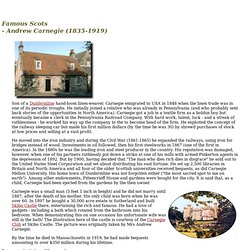
He initially joined a relative who was already in Pennsylvania (and who probably sent back stories of the opportunities in North America). Carnegie got a job in a textile firm as a bobbin boy but eventually became a clerk in the Pennsylvania Railroad Company. With hard work, talent, luck - and a streak of ruthlessness - he worked his way up the company to the to become head of the firm. He exploited the concept of the railway sleeping car but made his first million dollars (by the time he was 30) by shrewd purchases of stock at low prices and selling at a vast profit. He moved into the iron industry and during the Civil War (1861-1865) he expanded the railways, using iron for bridges instead of wood. Carnegie was a small man (5 feet 1 inch in height) and he did not marry until 1887, after the death of his mother.
Carnegie Hall. Designed by architect William Burnet Tuthill and built by philanthropist Andrew Carnegie in 1891, it is one of the most prestigious venues in the world for both classical music and popular music.
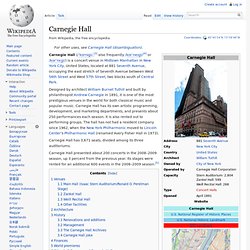
Carnegie Hall has its own artistic programming, development, and marketing departments, and presents about 250 performances each season. It is also rented out to performing groups. The hall has not had a resident company since 1962, when the New York Philharmonic moved to Lincoln Center's Philharmonic Hall (renamed Avery Fisher Hall in 1973). Carnegie Hall has 3,671 seats, divided among its three auditoriums.
Carnegie Hall presented about 200 concerts in the 2008–2009 season, up 3 percent from the previous year. Venues[edit] Carnegie Hall contains three distinct, separate performance spaces: Main Hall (Isaac Stern Auditorium/Ronald O. Isaac Stern Auditorium Carnegie Hall's main auditorium seats 2,804 on five levels. Carnegie Hall - NYC Concert Tickets, Events, and Music Education. Carnegie Hall - Carnegie Hall, Dunfermline. Situated at the heart of Dunfermline, Carnegie Hall is an attractive art deco theatre which presents a quality programme of music, drama, comedy, dance and children’s shows, including a popular Christmas show.
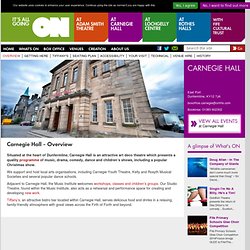
We support and host local arts organisations, including Carnegie Youth Theatre, Kelty and Rosyth Musical Societies and several popular dance schools. Adjacent to Carnegie Hall, the Music Institute welcomes workshops, classes and children’s groups. Our Studio Theatre, found within the Music Institute, also acts as a rehearsal and performance space for creating and developing new work. Tiffany’s, an attractive bistro bar located within Carnegie Hall, serves delicious food and drinks in a relaxing, family-friendly atmosphere with great views across the Firth of Forth and beyond.
Andrew Carnegie Birthplace Museum. THE CARNEGIE DUNFERMLINE TRUST. History: Andrew Carnegie and Carnegie Libraries. Early Carnegie Libraries. Central Library, Dunfermline. Opened 25th August, 1883 The architect of the Dunfermline library, James Campbell Walker of Edinburgh, combined a mixture of disconnected styles to somehow produce a design that works as a whole. The library has a Gothic entrance which contains a carved sun with Carnegie's "Let there be light" motto in the banner below.
In contrast to the doorway, the building is crowned with corbelled turrets more reminiscent of a French château. The remainder of the frontage is less elaborate with regular evenly spaced windows. Mrs Margaret Carnegie, Andrew's mother, laid the library's memorial stone, on 27th July 1881 when they returned to the town they had left 33 years earlier. Victoria Library, Grangemouth. This was Scotland's second Carnegie library, completed just two months before America's first Carnegie library opened in Braddock, Pennsylvania on 30th March 1889.
The library is housed in a two storey neo-classical building designed by William Black of Falkirk. Sparks - How Do I Get To Carnegie Hall.